#city design
Text
Fuck hostile architecture, I want unhostile architecture. I want benches to be designed to be as easy as possible to sleep on. I want little places for pigeons to nest to be purposefully put on buildings. I want people designing public spaces to think about what they'd be like to skateboard on. I want "Please loiter" signs. I want people to be kind. I want...
#my thougts#196#words#hostile#hostile architecture#anti homeless architecture#architecture#desgin#homeless#leftist#leftism#praxis#urbanism#city design#socialism
36K notes
·
View notes
Text
I really want to talk about how important it is for us as a people to start making proper city design a priority. I also want to talk about how the privatization of land is the first major barrier to having proper city design.
A lot of seemingly complex issues and tasks can be simplified or made easier to deal with by organizing our cities: Food distribution, commute times, housing, neighborhood safety, public transportation, business/practice regulation, emergency preparedness, general accessibility, mental health, access to medical services, public health, and probably a ton of other things I can't think of right now.
All of that and more could be made much easier if we organized our cities with things like mixed-use-development, the standardization of public transport over personal vehicles, a grid structure, prioritizing walkability on surfaces safe for the disabled (sidewalks over cobblestone), designating districts for certain kinds of services, mandating better minimum (and maximum) size requirements for homes, requiring a certain percentage of greenery or some form of nature for every square footage, and other tactics that I'm probably not even aware of since I'm no city planner.
All of this gets shit on when land can be privately owned, though. Businesses, rich folks, the greedy, and the ignorant buy land without any planning in mind for their community which leads to disorganized, unoptimized, and community-unfriendly cities/towns. Our efforts should always generally lead to the betterment of our community over the selfish betterment of our private circumstances.
#don't forget to unionize your workplace#union#worker rights#r/196#196#power of the people#progress#workers#workers rights#city design#city life#city/town#organization#solarpunk#socialism#communism#communist#tumblr#punk#bright future#hope#eat the rich#anti privatization#landlords#do a crime to the rich#make the abusers of power fear for their lives#crime bois#lqbtq community#disabled community#activism
279 notes
·
View notes
Text
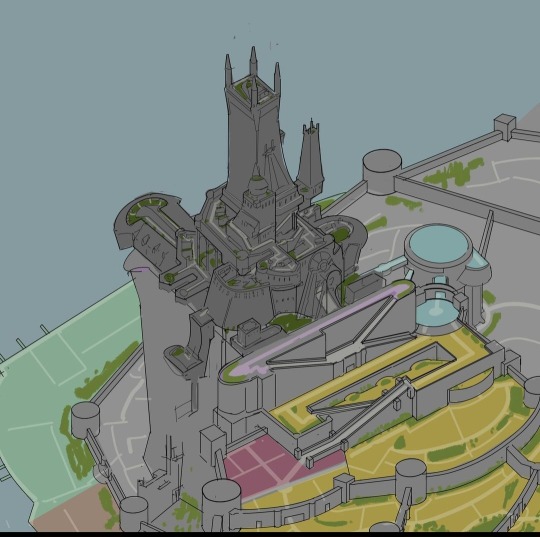

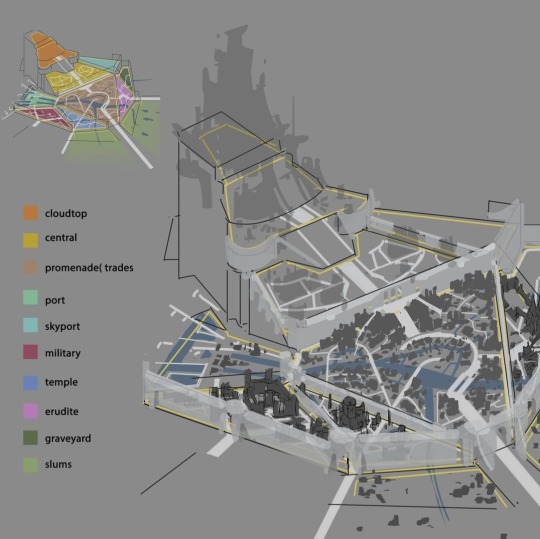
THE LEGEND OF VOX MACHINA | Emon City Design
By Arthur Tang
#vox machina#the legend of vox machina#tlovm#critical role#emon#production design#concept art#city design#animation#titmouse inc.
265 notes
·
View notes
Text
Bland buildings are less offensive when they're part of an overall great urbanism
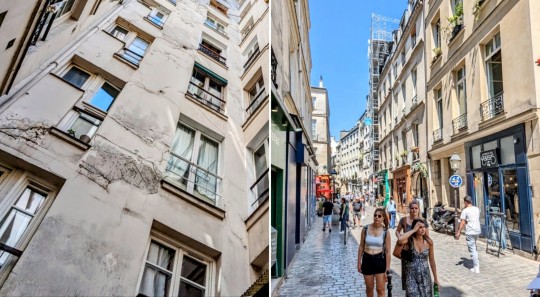
Something occurred to me while walking around Paris last week during a vacation visit...
If you zoom in on average Paris buildings, many resemble the apartments that often get pegged as being "cookie cutter, soulless density" in Atlanta. They may not be exactly as bland as the worst offenders in Atlanta, but they can be pretty dull in themselves, relative to the grandest architecture in the city.
But when you zoom out to their full context, to see how they're grouped closely together against pedestrian-focused streets, with shops on bottom, they look glorious.
This is the physical aspect of good urbanism that matters so much.
It's about creating public streets scaled primarily toward the movement of humans, and less toward the movement and parking of cars.
It's about streets where many things are in walkable distance, and where the doors and windows of buildings are politely close to pedestrians instead of being set back behind unused landscaping or parking spaces (though if I was rebuilding Paris, I'd definitely leave some room for more street trees).
Of course, individual buildings that are set back from the street in less pedestrian-oriented formats can be beautiful and beloved in themselves.
But in terms of scaling large populations upward in a way that sustains walking (versus car dependency), prioritizing compact density is important. And in the process, bland architecture is more forgivable because the aesthetic of the larger place is what's most important.
It's a challenging argument to make because I realize that Atlanta's dullest architecture is much more offensive than the bottom rung of what you find in Paris.
But in a classic European city where there's a lot of really grand, elegant, detailed architecture (much more so than what we have in Atlanta), the ones I posted here count as what I'll call "bland background buildings" by comparison.
It's only when you crop it specifically into pieces that you can see "oh, this building doesn't particularly stand out in terms of architectural details, but the entirety of the street is gorgeous anyway," and that's because of the overall structural urbanism happening.
I think there's a lesson for Atlanta in that. Yes, there's value in improving some details of our dull architecture. But the most important improvement in our design needs to happen at the level of streets and neighborhoods.
#paris#urbanism#architecture#urbanisme#walkability#urban planning#urban design#city design#walkable cities#human scale cities
174 notes
·
View notes
Text
I kinda have a thing for city design and I've been rolling this idea around in my head for a while, and i think it's come to this; 240 lots ranging from 2500-3600 sq meters, all residential, with 16 3600 sq meter commercial complexes scattered throughout, all within a sq km. The idea is pretty simple: one lot can hold a family and a small farm, or one high density housing structure. High density housing allows for staffing of commercial complexes and housing for remote workers and others who don't want to tend a yard/garden. The one family plots don't even need to be farms, the land can be developed elsewise, as a trade shop or other small business. Furthermore, a full half acre of land is a solid amount of farmland, either in a traditional farm, as an orchard, or even as a ranch or bee farm. Having 16 total commercial complexes scattered across this residential complex means that more people would be able to set up small businesses outside of their houses as well, and allow all residents to have easy access to stores of all kinds. The middle of this lot would likely be dedicated to 1-4 superstores, with a ring of smaller stores around. With none of this needing parking due to the proximity of houses, you could maximize commercial real estate, allowing for maximal convenience, having everything you could need right at hand.
And here's the thing; This needs a socialist underpinning, allow everyone a place to live, not just because it's the right thing to do, but because living on land develops the land, and living in a complex will inevitably contribute to the economy in other ways. Rent is not charged because it is not necessary, living there and actively participating in the economy is good enough. And, in order to really get the economy stimulated, everyone can be afforded a monthly budget, free of charge, that they can then spend on everyone else's goods, which then get taxed via sales or income tax, feeding back into the system. Add tariffs and service fees for mail, waste disposal, and utilites, and now your government is able to generate revenue not only to feed the socialist programs, but to maintain infrastructure as well.
68 notes
·
View notes
Photo



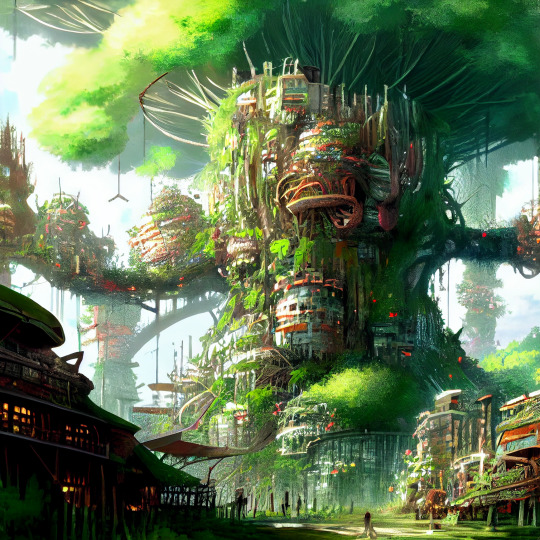
Don’t just integrate yourself with nature, integrate the whole system.
Solarpunk question: Could we use genetically engineered “super trees” as structural bases for human infrastructure?
How would you integrate nature into our systems as a species?
#solarpunk#solar#punk#ecopunk#cottagecore#ecology#ecofriendly#eco movement#solarpunk art#greenhouse#tree#artificial intelligence#ai#art#painting#treehouse#treehouses#apartment#city design#urban#design#cityscape#imagine#optimisticfutures
250 notes
·
View notes
Text
#good news#science#nature#environmentalism#environment#climate change#climate crisis#flooding#climate adaptation#climate resilience#city design#infrastructure
40 notes
·
View notes
Photo
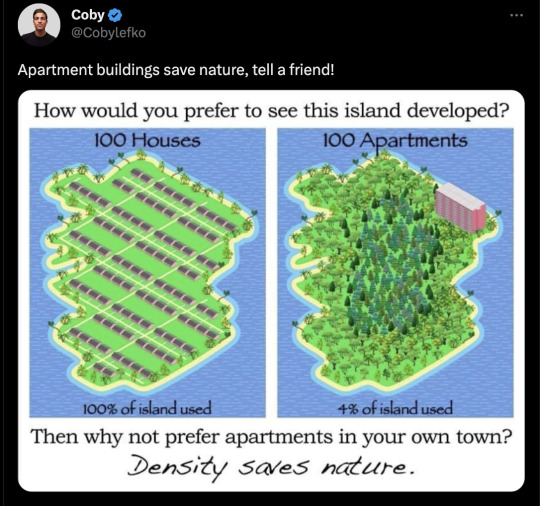
The graphic in this tweet is a gift. Thank you! 🙌
136 notes
·
View notes
Text
So far, the only even remotely coherent arguments I've seen against prioritizing walkability in city design are:
Do you trust city councils to implement this? (You seem to trust them with the current zoning allowance)
They're gonna ban cars! (No they fucking wont and you know this)
I dunno, it's just, it's different, different is scary it must be bad! (Please seek therapy)
Some especially disingenuous people may claim walkable cities are "ableist/bad for disabled people" but it's never actually disabled people making that argument, it's just an extension of the "they're gonna ban cars" argument (claiming that disabled people need cars to get around), and also ignores how dangerous car centric city design is for disabled people, lots of streets don't even have sidewalks and you frequently have to cross 5+ lanes of traffic to cross the street which includes having to go down and up two ramps.
The only people walkable cities are bad for are Jennifer, Mike, David, Amy, and Kimberly and their giant pedestrian killing land yacht SUVs and Pickup Trucks, and, good, fuck em.
23 notes
·
View notes
Text
anyway this reminds me of this WILD concept that's been adopted in German cities which they call "Grüne Welle" (green wave) where they coordinate traffic lights on long roads so that if you go about as fast as the speed limit, all your traffic lights will be green and you won't have to stop. this is to aid traffic flow, reduce emissions and it also makes driving so much less frustrating.
the uk has never heard of this concept and is allergic to implementing anything that would make the lives of its citizens easier. you WILL stand at every traffic light. it is faster and easier by far to navigate cities here by bike (but quite unsafe). if you're used in any way to user-friendly city design, you will fucking suffer driving in uk cities
please tell me if this green wave is a thing in other places??? or if its a german exclusive??? thank you
#i need a tag for my own rambles#german tag#german#deutsches zeug#uk#city design#green wave#grüne welle#traffic lights
108 notes
·
View notes
Text
Solarpunk Aesthetic Week Final Day: Worldbuilding Thoughts Three!!!
Because my silly little brain is hyperactive as heck.
"It takes a village to raise a child"? That's true now. The kids in the commune don't need to have dictated caregivers, they just chill with who they want. Houses welcome to children can be marked with a special symbol- Every adult who feels comfortable with kids is in a special groupchat (or the like) for the collective parents to chat about how their kids are all doing. Those adults who don't want to be kid-raisers don't join the group chat and don't mark their house, and kids are taught to not to bother them.
We all pitch in to help with the commune, but also to cover each other on days we can't work for whatever reason! Is it shabbat? Is your mom sick? Are your migraines bad today? Are you feeling burnt out? Do you just not want to? Then you don't have to work to do anything. Of course, a whole lot of manual labor (such as milling wheat and other grains into flour) would be automated with robots! The ickiest worst jobs aren't for anyone.
Lights! Lights on Hanukkah, on Diwali, on Christmas. Window-shutters close automatically on houses past sunset so inhabitants can have their lights on without polluting and confusing animal life. Floating lanterns, a soft glow on a gentle face, kids laughing with fireflies cupped in their hands, a dazzling array of stars blinking quietly down on the Earth..
Allergies, intolerances, and food sensitivities are all respected and taken careful note of, and restaurants offer a diverse array of options including vegan meals and allergy-friendly kosher and halal menus!
Kids are considered kids until their brain is fully developed, but are given agency as soon as they can articulate and move themselves. Kids aren't allowed to leave the commune without supervision, though, but inside the commune it's totally alright cuz eyes on the street.
High-tech hormone readers on cameras with AI trained to detect signs of distress and assault, and begin blaring a loud alarm, could be placed wherever. I'm not one for surveillance states, but if we have fire alarms, we could have alarms for other things too, right?
Communal service dogs! Someone had a seizure, a stroke? BARK BARK BARK BAKRBABRKABABRK
In the cities, perhaps a commune is considered your 15-minute sphere? They're divided and governed as such, but cities can also have higher levels of division if necessary.
Food factories! Greenhouses the size of commercial warehouses, giant aquaponics facilities, all kept by robots and an automatic delivery service to restaurants or homes or wherever need be.
That concludes this set of thoughts, and this Solarpunk Aesthetic Week! Woohoo! I hope everyone had a wonderful time <3
#text post#worldbuilding#solarpunk aesthetic week#solarpunk aesthetic#solarpunk#solarpunk worldbuilding#solarpunk world#city planning#urban design#urban planning#city design#post capitalism#high tech high hope
32 notes
·
View notes
Text
Honestly shout out to cities that are just a giant walled circle with a big ass tower in the middle. Real life cities need to step up




This is the shit right here. Only Baghdad managed peak city design irl. Modern grid cities wish they had what she has
15 notes
·
View notes
Text
What the fuck is up with our minimum housing standards? Why is it even an option to have a 500sq ft apartment?! Every living space ahould be designed to be a properly sized god damned home. It's not like we're lacking the land to have this be possible.
Any time a living space is created, there needs to be a minimum of like 900sq ft for a one person home, and multiply that by like 1.5 for every additional planned occupant. No one shouod be cramped.
And this isn't even getting into proper closet space requirements, safety standards,outlet availability,natural light requirements, noise dampening standards, quality of building material standards, and everything else related to housing that makes living more of a pain than it needs to be.
There needs to be a humane standard of housing quality for everyone. Housing should also just be a right and free. Rent and mortgage is a scam, and landlords/realtors need to be dragged into the street and "disposed of".
#cozy living#housing#landlords#this is a hellscape#r/196#reddit blackout#union#don't forget to unionize your workplace#worker rights#living standards#city design#minimum standards#eat the rich#eat the 1%#this timeline is about to make me wild out#tumblr#power of the people#people#apartment#apartments#crime bois#do crimes to the rich
52 notes
·
View notes
Text
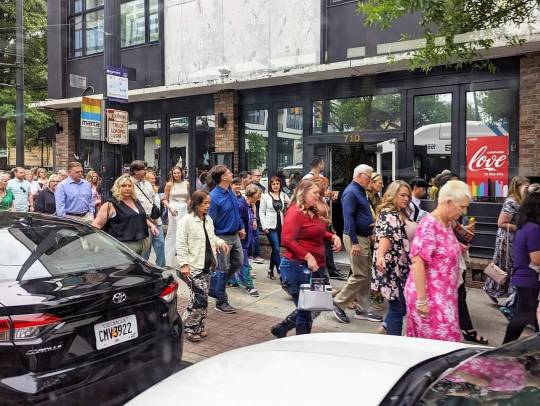
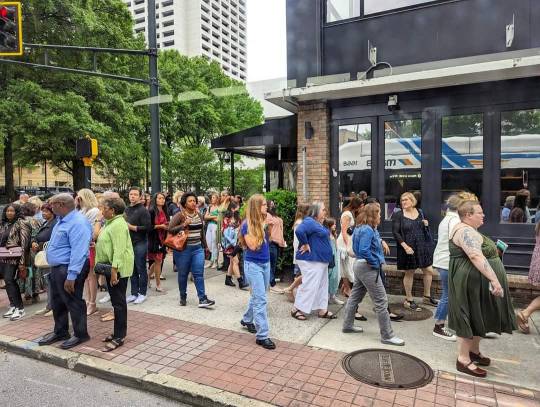
Seen from a MARTA bus: crowds exiting the Fox Theater, walking in the direction of parking decks. Notice how little space they occupy on sidewalks, versus the space they'll take once they're spread out into hundreds of cars.
I don't blame them for driving. The metro area was intentionally built in a sprawling format for driving, with alternatives being a distant afterthought. It's a logical mode choice given the awful state of our regional urbanism.
I blame the people who actively oppose changes to the status quo -- people who fight against rezonings that would allow us to retrofit even the smallest level of density inside the vast areas devoted to detached, single family homes.
And I blame the people who actively oppose the mixing of corner stores into residential areas, or the addition of bus lanes or bike lanes onto our wide, car-sewer streets.
Alternatives to driving are better enabled by a built environment that is more compact -- one that's scaled for walking and cycling and transit service, rather than being scaled exclusively for personal cars.
This is the kind of thing I think about while riding a bus and looking out the window at the city.
24 notes
·
View notes
Text

A "keep moving" sign in slip lane, where pedestrians need to safely cross, is a ridiculous thing. To put one on a MARTA bus route is arguably a homicidal decision, creating a kind of firing squad for transit riders.
The windshield perspective we have on the world, as car drivers, seems to hurt our ability to design streets with empathy for pedestrians. That's the only rational answer I can find for deadly designs, especially given the presence of people who truly rely on transit.
Also, we prevent transit systems from being able to compete with driving when we make it dangerous to walk to and from a bus stop. It's a cycle of street-design behavior that needs to end.
[Note: this specific sign was changed a few years ago to a "watch for pedestrians" one. It only happened following the death of Ramona Devore. It shouldn't require death to prompt this change. When pedestrians die, leaders will sometimes act and retrofit safety measures, bit by bit. We need to preemptively design for safety.]
#pedestrian safety#urban design#urban planning#transportation planning#city design#street design#dangerous by design#city planning#urbanism
38 notes
·
View notes
Text


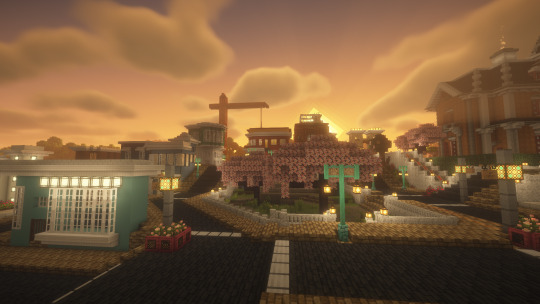


My new(ish) minecraft city - San Crafto
3 notes
·
View notes